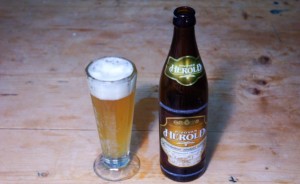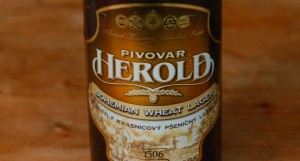
You hit the road for a few days of peace and solitude in South Bohemia and what happens? A great beer that has been AWOL for years suddenly returns to the scene.
The brew in question is the very nice wheat beer from Pivovar Herold, a brewery I pass each time I drive down to my wife’s family’s summer home in Písek. As I’ve mentioned before, the history of the brewery in the town of Březnice is covered in Ludvík Fürst’s monograph “Jak se u nás vařilo pivo” (or “How we used to brew beer”). In that book, Fürst quotes documents mentioning the production of wheat beer at Březnice in the sixteenth century. When Herold reintroduced its modern wheat beers in 2002, they were the only Czech wheat beers available in bottles at the time.
That seemed to set off a small wheat trend here. Today, of course, we’ve got the nicely clove-scented Weizenbier from Pivovar Primátor, which is available in Tesco and other big supermarkets around the country. Many brewpubs have started brewing their own wheats; the Duchmaus wheat beer from Pivovar U Rybiček is even distributed in plastic bottles, a new development for many small Czech brewers. And yet as far as I can tell, Herold — one of the first Czech producers to make a name with wheat beers in the recent era — stopped brewing its own wheat by 2007.
Then came last summer’s change of ownership. While the brewery’s black lager remained strong enough to inspire imitations abroad, there were whispers that the new owners might make some changes, including the reintroduction of the wheat. And then, just in time for summer, a shipment of Herold’s wheat beer was delivered to Pivovarský klub in Prague on Thursday, May 14.

There’s something interesting on the label: in English, Herold identifies this beer as “wheat lager,” which seems to present a contradiction. As many beer fans know, “lager” is often used as a term for bottom-fermented beers, while wheat beers are mostly top-fermenting. However, that doesn’t mean that this is a wheat-lager hybrid; as I understand it, this beer is still made using traditional top-fermenting wheat beer yeast. Instead, the term on the label is an English-language approximation of the Czech brewing term “ležák,” which refers to the relative strength of the beer, covering those beers produced at 11° and 12° Plato or Balling. (The term “výčepní,” literally meaning something like “tap” or “taproom,” covers beers brewed at 9° and 10°, even those which are not served on tap or in taprooms.)
So how does Herold’s “wheat lager” taste?
Good. It pours a very pretty, cloudy gold with a fluffy white head. There’s not nearly as much clove in the nose as in other beers; instead, I thought I noted tobacco before I detected a bit of clove on the palate as well as some pronounced barley malt flavors. Perhaps it’s the “wheat lager” on the label, but I thought it was a very Pilsner-like Weizen, reminding me of Weltenburger’s Hefe-Weißbier Hell in its citrus notes. It has a very light body and is very easy to drink.
The next time you drive by Březnice, you have a very good reason to stop and pick up a case. And while Primátor’s Weizenbier has had a near-constant presence on Pivovarský klub’s tap #6, that should change in the near future: the delivery last Thursday included bottles as well as several kegs, meaning you’ll be able to try Herold’s wheat beer on draft at Pivovarský klub for a good while to come.




pivnizub
Good luck to Herold ! But is in Bohemia really a market for Weizenbier ? I remember that – a short time after the velvet revolution – Prazdroj launched also a Weizen; first they called it “Prior” (an old brand of the PU trust from the 1930’s), later Gambrinus Bile. It seems, that it wasn’t a very big commercial success, because the production stopped already in the 90’s.
Primator Weizen is widely available, but I’ve never seen a czech pivař buying or drinking it….. So who is really – besides tourists – keen on Pšeničné pivo in the czech countries?
Javier
There’s definitely a market (perhaps not that big) for weizenbeers in Bohemia… the thing is the Primator which has been recently added to a few supermarkets (albert), lacks support on the hospodas and bars…. stop by U Sadu and u can see czechs buying it… (on my part im always trying to get people to taste it at least, a couple of times, that is). In Bavaria is widely popular, and theirs is not as good as ours (not biased) so why not here???…. It’s just unnerving to see all this marketing strategies working on people drinking gambac … while there are lots of better brands out there… Primator weizen is just amazing.
Evan Rail
Hey Javier, Dr. Beertooth, thanks for your comments. I agree with Javier, there is definitely a small (but growing) market for wheat beers here. I wouldn’t call Primátor Weizenbier a beer for tourists, as it’s not available in most (or any?) tourist bars; at places like U Sadu you can definitely see locals drinking and enjoying it. And since it’s starting to be widely carried in supermarkets like Albert and Tesco, where I bought a few bottles this week, you’d have to imagine that it is being bought by at least some Czech pivaři. (I’m not sure if Javier and I count as Czech pivaři, but still.)
The thing that’s interesting is that even if wheat beer sales make up just the smallest percentage of the market here, the resulting number could end up being quite large if that percentage increases even slightly. You’ve got 10 million people who drink some of the largest amounts of beer per capita in the world. If Czech consumers bought a wheat beer just 6% of the time, that would amount to a million hectoliters. I’m not saying that’s going to happen soon, but it certainly has potential.
Elf
toJavier: Bavarian wheat beers are not as good as what? As czech wheat beers? If I’ve understood you correctly, I must say: don’t kidding me and don’t kidding anybody.
Evan Rail
I must say: don’t kidding me and don’t kidding anybody.
According to Google Translate, that means “I don’t agree with you.”
Elf
Yes, it means “I don’t agree with you”. I really like Primátor Weizen and Herold Wheat Lager, but they still can’t be compared with Hefeweizen from Germany (precisely from Bavaria). In this case tradition is tradition and anybody can find out.
Evan Rail
I agree that tradition is tradition, but two points:
1. Though there are many flavors in wheat beer, “tradition” isn’t one of them.
2. There’s a very good chance that the tradition of wheat beer originally came to Bavaria from Bohemia.
That doesn’t mean that Primátor and Herold are better than Bavarian wheats: I’m definitely not saying that. Nor does the “tradition” of wheat beer in Bavaria make it better than wheats in the Czech lands. (The “tradition” of brewing IPAs in America is fairly short, and I don’t think anyone would say that the American versions are, therefore, not as good as the IPAs brewed somewhere else.)
I can say that I recently did a blind tasting with two Bavarian wheats, the Weltenburger Hefe-Weißbier Hell I mentioned and the Schneider Weisse Hefe-Weizenbier, along with Primátor Weizenbier, and everyone who tasted these beers blind put the Primátor ahead of the Weltenburger (and many even put Primátor ahead of Schneider). My tasting notes say that Primátor had the most clove aroma and the most citrus flavors in the mouth. Weltenburger had the lightest body with some corny, grainy notes that turned some tasters off.
So beyond the appeal of “tradition,” what specific Bavarian wheats do you like? And what specifically about them do you prefer?